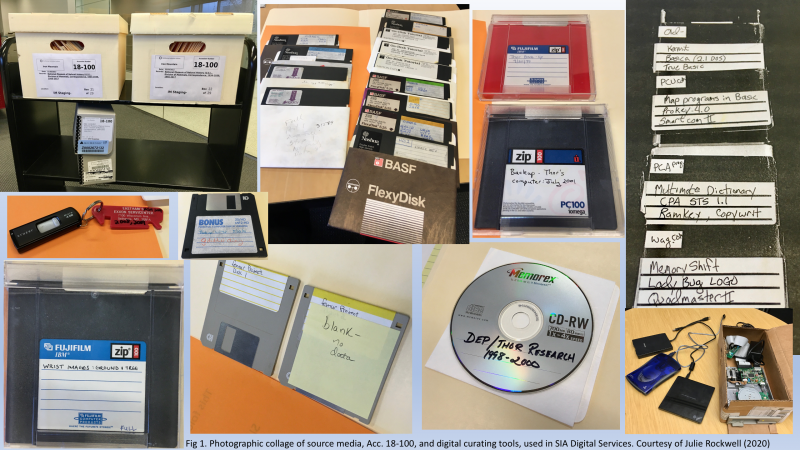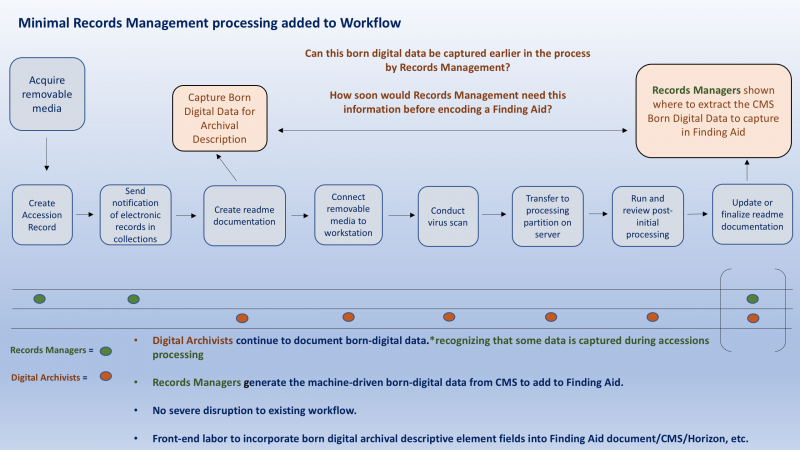“Don’t lose the context and interrogate the floppy!” are the wise words of independent historian and Archives research associate Marcel C. LaFollette, whom I met during my digital curation internship with the Digital Services team. Along with the director of digital services Riccardo Ferrante, we discussed my project, Born-Digital Collections Access Research and Planning. I sought to document the current levels of access researchers had to born-digital collections, and then research archival practices that would further enhance that access, impact, and reach. Persistent questions and concerns that have addressed both archivist and researcher permeated the initial discussions.
How are collecting institutions managing the influx of born-digital materials into their repositories?
What are the latest ‘best practices’ to maintain the authenticity and integrity of the electronic record?
Are describing and maintaining the source media important to the researcher – do they only want the content in whatever preserved format?
Is the context in which content was created relevant?
In the pursuit of answers to these questions, I reviewed the latest developments in the archival field regarding born-digital collections access and archival description.
Driven by the question “Are we, the Archives, doing enough?,” I set out to recommend at least three improvements to the Archives’ current born-digital access practices. The improvements primarily focused on enhancing the online finding aid descriptions. At the time, collections that included born-digital material simply listed “Electronic Records” in the summary, descriptive entry, physical characteristics of materials in the collection, and at the item level.

LaFollette’s insights as a researcher proved invaluable to my study. Her inquiries into how the Archives processes born-digital materials while maintaining their authenticity and integrity, i.e. preserving the actual data and its original source media without losing inherent characteristics while minimizing threats to usability, guided my improvement strategies. “Don’t lose the context and interrogate the floppy!” should become the born-digital access battle cry for archivists and researchers everywhere.
The first two strategies I recommended to the Archives are to 1) add new fields to the Archives’ collection management system (CMS) making it possible to 2) incorporate the University of California Guidelines for Born-Digital Archival Description (2017) into the online finding aids. The guidelines provide the first published, born-digital archival descriptive elements model intended to enhance the description of born-digital materials and their source media found in collections. The addition of more granular metadata identified through fields that highlight born-digital materials is of potential interest to the researcher. It would be readily discoverable from the online finding aid access points.

For my third strategy, I suggested minimal adjustments to the Archives’ born-digital workflow so that varying levels of born-digital materials metadata, much of which already exists within the Archives’ CMS, is captured by both the records managers and digital archivists during processing and finalizing the accession record.

Thinking beyond the Archives’ finding aids and internal workflows, I developed a fourth strategy focusing on public outreach. Beginning with this post, The Born-Digital Diaries, a new blog series, will highlight Archives staff discoveries as they engage with born-digital materials. Staff is encouraged to share their work from a variety of perspectives as they continue to implement best practices beyond emerging standards. The Born-Digital Diaries will connect readers to the Archives’ forward-thinking stewards who care for the ever-increasing volumes of born-digital materials and source media accessioned into the Archives each year.
Academic libraries across the country, such as the University at Buffalo Libraries and Yale University Library, have recently shared new practices for improving born-digital collections access. And many other repositories have accelerated the pace to apply improved practices to born-digital materials processing and levels of access. For the Archives, the most significant obstacle towards improving practices is time. However, now is the time to better communicate to researchers about the born-digital holdings the Archives’ Electronic Records Program has been preserving for over a decade. And what better time than to interrogate the floppy while the essence of the floppy still exists.
Related Resources
- “It’s a Squirrelly Kind of Day,” by Lynda Schmitz Fuhrig, The Bigger Picture, Smithsonian Institution Archives
- Arroyo-Ramírez, E., Bolding, K., Butler, D., Cobourn, A., Dietz, B., Farrell, J., Helms, A., Henke, K., Macquarie, C., Peltzman, S., Watson, C.T., Taylor, A., Venlet, J., & Walker, P. (2020, February). Levels of Born-Digital Access, version 1. Digital Library Federation (DLF) Born-Digital Access Working Group.
- Clemens, A., Anderson, S., Bunde, J., Butler, D., Chassanoff, A., Farrell, J., Farrell, M., Helms, A., Walker, P., & Weintraub, J. (2020, March). Collecting User Experiences, Needs, and Desires for Accessing Born-Digital Archival Collections: Survey Analysis. Digital Library Federation (DLF) Born-Digital Access Working Group, Access Practices and Outreach subgroup.
- Kim, J.Y. (2018). Researcher Access to Born-Digital Collections: An Exploratory Study. Journal of Contemporary Archival Studies, 5(7). 1-11.
- Owens, T. (2018). The theory and craft of digital preservation. Johns Hopkins University Press.
- Shein, C. (2014). From Accession to Access: A Born-Digital Materials Case Study. Journal of Western Archives, 5(1). 1-42.
- Waugh, D., Roke, E.R., Farr, E. (2016). Flexible Processing and Diverse Collections: A Tiered Approach to Delivering Born Digital Archives. Archives and Records, 37 (1), pp. 3-19.
Produced by the Smithsonian Institution Archives. For copyright questions, please see the Terms of Use.

Leave a Comment